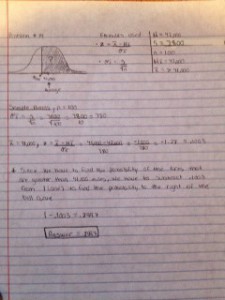Candice Wright
14. One tire manufacturer claims that his tires last an average of 42,000 miles with a standard deviation of 7800 miles. A random sample of 100 of his tires is taken. What is the probability that the average of these 100 tires will last greater than (to the right of) 41,000 miles?
First: We figure out what type of problem the question is and what is the question asking.
This is a sampling means distribution question (the same as day 20’s handout.) We know this because it is stated in the question, underlined above (random sample). The question is asking for the probability of 100 tires greater than 41,000 miles, so this means that our answer has to be between 0 and 1.
Second: We find the mean(µ), n, x-bar, and standard deviation S/σ where the mean/average (µ) stated above is 42000, n is 100, S/σ also stated above is 7800 once we know these numbers we could plug them into the formulas below to solve the problem. (formulas used included)
Mean (µ) = 42,000
S/σ= 7,800
n = 100
x-bar = 41,000
Formulas Needed
1. Sampling Distributions: for standard deviation σx-bar: S/√n
2. Sampling Distributions convert x-bar to z: z = (x-bar – μ) / σx-bar
*We use the sampling distribution formulas rather than the normal distribution formulas because we are working with samples.
Third: Construct the Bell curve and map out which side of the curve we are finding the probability for. (see inserted picture). We have to find the probability to the RIGHT of the bell curve so we have to subtract 1 (one) from the x’s Z score. Why? Because the table only gives us the Z score to the left not the right.

Solving the problem
Step 1: We find the standard deviation for x-bar first because this answer is used as the denominator for the following step.
σx-bar = S/√n= 7800/√100 = 7800/10 = 780
Step 2: we use the sampling distribution formula for x-bar to convert our x to z.
z = (x-bar – μ) / σx-bar = 41000-42000/780 =(41000-42000=-1000) -1000/780= -1.28 (round answer to nearest two decimals)
*Note: we round the answer to the nearest two decimal places because we are finding the Z score and we only need two decimal places.
Step 3: We look up the Z score in the table
-1.28 –> .1003
Step 4: .1003 would have been our answer if we were finding x to the left of the bell curve. In this case we have an extra step and that is to find x to the right of the bell curve. There are two ways in finding the Z score to the right of a bell curve.
1. Take the Z score and switch the sign. (it will either be positive of negative so the opposite sign of whatever your Z score is)
-1.28 –>1.28
Then we will just look up the Z score in the table and find our answer (x).
1.28 –> .8997
2. Or you look up the Z score in the table to find your X and then subtract that number from 1 (one) and that would be the answer.
-1.28 –> .1003 1 – .1003 = .8997
*Moral of the story, whichever way you feel comfortable using, you will get the same answer.
Step 5: Check back to see what the problem was asking and see if we answered it. In this case we did, so the problem is now complete.
Answer: .8997



